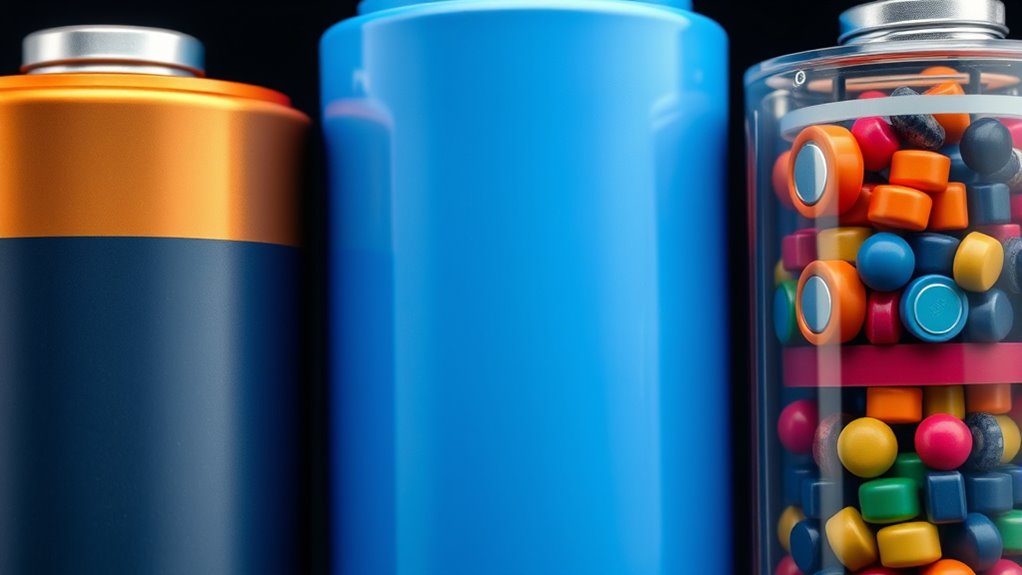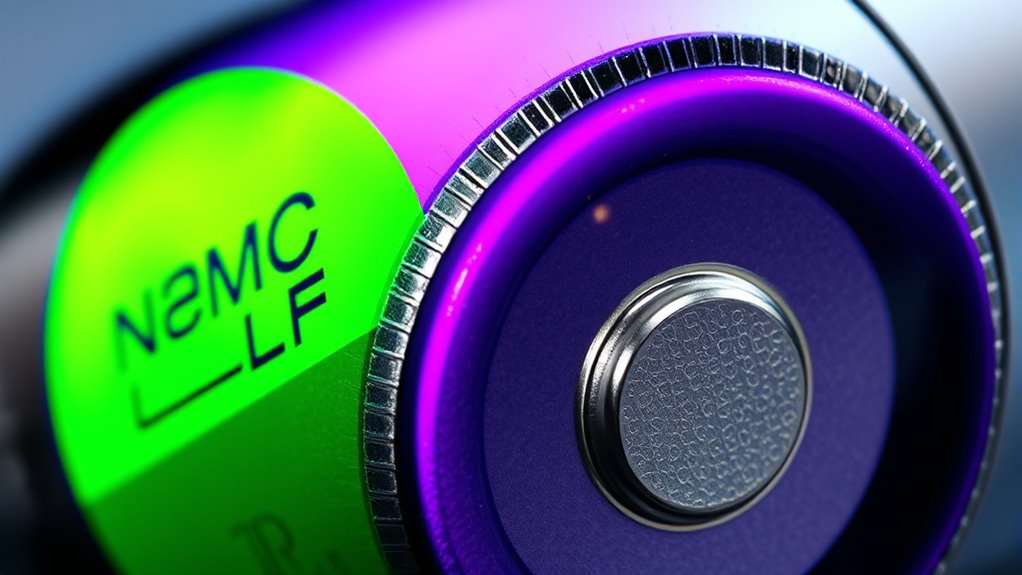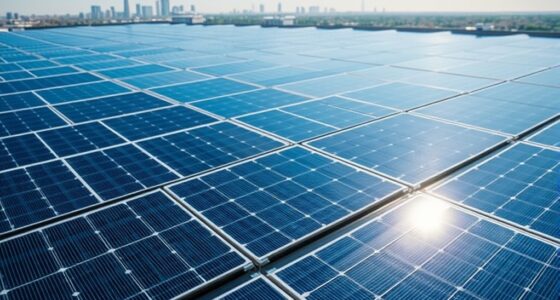Battery chemistries like LFP (Lithium Iron Phosphate) and NMC (Nickel Manganese Cobalt) influence the safety, performance, and environmental impact of energy storage systems. LFP offers stability and safety, making it ideal for stationary use and some EVs, while NMC provides higher energy density, suitable for portable devices and advanced EVs. Each chemistry has unique handling and recycling needs. Exploring further reveals how these options shape the future of sustainable energy solutions.
Key Takeaways
- LFP batteries prioritize safety and stability, with straightforward recycling, making them ideal for stationary storage and some EVs.
- NMC batteries contain valuable metals like cobalt and nickel, offering high energy density but require complex recycling processes.
- Battery chemistries vary in safety profiles, with LFP being less prone to thermal runaway compared to NMC.
- Emerging chemistries include solid-state and lithium-silicon, aiming for higher safety, capacity, and environmental sustainability.
- Understanding different chemistries helps optimize battery selection for performance, safety, environmental impact, and recycling efficiency.

Battery chemistries are the foundation of modern energy storage, influencing everything from smartphone performance to electric vehicle range. Understanding the different types, like Lithium Iron Phosphate (LFP) and Nickel Manganese Cobalt (NMC), helps you grasp how they impact safety, longevity, and environmental impact. Each chemistry offers unique advantages and challenges, especially when it comes to safety protocols and recycling methods.
LFP batteries are known for their stability and safety. They are less prone to thermal runaway, which means they’re less likely to overheat or catch fire compared to other chemistries. This makes them a preferred choice for applications where safety is a top priority, such as stationary energy storage and some electric vehicles. When you handle or store these batteries, following strict safety protocols is essential. Proper ventilation, avoiding physical damage, and using appropriate charging systems reduce risks considerably. Recycling LFP batteries is generally more straightforward because they contain fewer toxic metals. You can recycle them through established methods that recover lithium, iron, and phosphate, which can then be reused in new batteries or other applications. This eco-friendly aspect makes LFP batteries appealing for sustainable energy initiatives. Safety protocols are particularly important for all battery chemistries to prevent accidents and ensure proper handling.
On the other hand, NMC batteries, which combine nickel, manganese, and cobalt, deliver higher energy densities. They’re commonly used in electric cars and portable electronics because they pack more power into a smaller size. However, they require rigorous safety protocols to prevent overheating or fires, especially during fast charging or if damaged. Proper thermal management, protective circuitry, and careful handling are crucial to avoid dangerous situations. Recycling NMC batteries is more complex because of their chemical makeup. The process involves extracting valuable metals like cobalt and nickel, which are in high demand. Developing efficient recycling methods reduces the environmental footprint and supplies critical materials for new batteries, helping to address resource scarcity.
In your journey with batteries, understanding these chemistries means recognizing the importance of safety protocols—whether it’s preventing accidents or handling disposal—and supporting effective recycling methods to minimize environmental harm. As technology advances, so do the strategies for making batteries safer and more sustainable. Staying informed about proper handling, storage, and recycling ensures you contribute to a safer, greener future. Each chemistry has its role, but safety and environmental responsibility must always come first, guiding the development and use of these essential energy storage solutions.
Frequently Asked Questions
How Do Battery Chemistries Impact Charging Speed?
Battery chemistries directly impact your charging speed because some, like LFP, support fast charging better than others. When you use fast charging, thermal management becomes essential to prevent overheating and damage. Chemistries optimized for quick charging allow higher currents, reducing your charging time. However, inadequate thermal management can cause safety issues or degrade the battery faster, so choosing the right chemistry and ensuring proper thermal control are key for quick, safe charging.
Are Some Chemistries More Environmentally Friendly Than Others?
Think of battery chemistries like different gardens—some flourish more sustainably. You’ll find that LFP batteries tend to be more environmentally friendly because they use abundant, less toxic materials, reducing environmental impact. Meanwhile, NMC batteries may have a bigger footprint due to material sourcing challenges. So, choosing a chemistry with eco-conscious sourcing can markedly lessen your environmental impact and promote a greener future.
What Are the Safety Concerns Associated With Different Chemistries?
You should be aware that different battery chemistries pose varying safety concerns. For example, some have a higher fire risk due to lower thermal stability, which means they can overheat or catch fire more easily if damaged or improperly managed. Lithium iron phosphate (LFP) batteries generally offer better thermal stability and are less prone to fire, while others like NMC may require more careful handling to prevent safety issues.
How Do Battery Chemistries Affect Overall Lifespan?
Your choice of battery chemistry can make your battery last longer or fade away like a fleeting dream. Different chemistries influence overall lifespan through factors like battery degradation and chemistry stability. For instance, some chemistries resist degradation better, extending lifespan, while others may degrade faster under heavy use. Understanding these differences helps you pick the right chemistry, ensuring your battery remains reliable and efficient over time.
Can Certain Chemistries Be Recycled More Efficiently?
Certain chemistries, like LFP, are easier to recycle because their materials are more stable and less toxic. Recycling processes for these chemistries enable higher material recovery rates, making recycling more efficient. You can benefit from improved recycling techniques that target specific chemistries, ensuring valuable materials are reclaimed effectively. By choosing batteries with chemistries optimized for recycling, you help support sustainable material recovery and reduce environmental impact.
Conclusion
Choosing the right battery chemistry is like finding the perfect recipe—you need the right ingredients for the best result. Imagine you’re assembling a puzzle, each piece representing a different chemistry like LFP or NMC. When you select the right pieces, your device runs smoothly and lasts longer. Just as a chef experiments to perfect a dish, understanding these chemistries helps you make smarter choices, ensuring your batteries serve you well, day after day.










